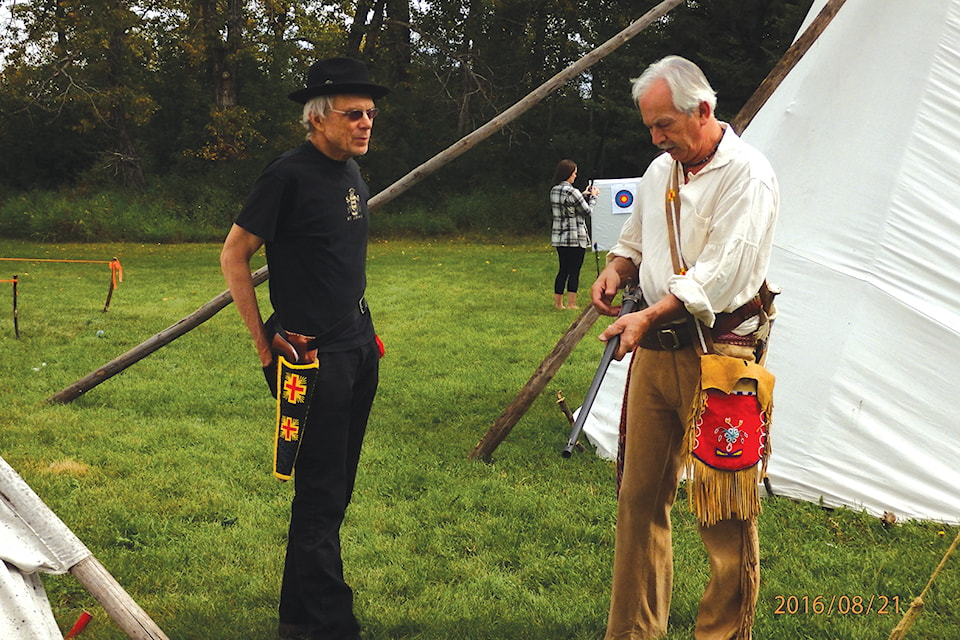Lyle Keewatin Richards was peacefully enjoying Red Deer’s Fort Normandeau Days celebrations when he was asked for a match.
The wife of the colonel of a group of historical reenactors explained it was to fire a cannon at an unarmed group of rebellious Métis as a mini recreation of the 1885 Rebellion.
“I said, ‘I’ll give you a match, but you’ve got to give me a gun.’ ”
So they handed Keewatin Richards a six-shooter and told him to fire away from the nearby bushes.
“And they fired back with a frickin’ nine-pound cannon,” he recalls with a laugh.
After that uneven matchup 30 years ago, Keewatin Richards was determined to come better prepared the next year. Since then, Living History Society members have used a variety of replica long guns, pistols and eventually their own cannon to defend their lands in what has become a popular annual showdown between Calgary’s 65th Mount Royal Rifles and Red Deer’s Firestick Living History Society.
For about a decade, the small group of history buffs has branched out to crafting replicas of a variety of pistols, from 18th century style flintlock pistols to U.S. Civil War-era percussion pistols.
Keewatin Richards has had guns all of his life, starting with a pellet gun when he was about five. He was introduced to building weapons by Ron “Doc” Cameron in the late 1980s, when they both worked at the then-CGTX rail company in Red Deer.
They started making knives and “one thing led to another,” says Keewatin Richards.
Cameron, a veteran member of the Living History Society, passed away in 2013 but his spirit lives on in Keewatin Richards’ garage, which is full of tools and other gunsmithing equipment rescued from Cameron’s home shop.
It was the discovery of a pair of partially finished pistols that prompted society members to finish the work Cameron had started.
“It’s always been really social to me,” says Keewatin Richards of the Friday afternoon gatherings when society members gather to work on their projects. Many of the historical pistols are made from kits imported from the U.S. and can range in price from several hundred dollars to $1,000.
Fellow society member Franz Hilsenbeck says he has been fascinated by history and weapons since he was a teen in Germany.
A cabinet maker by trade, he immigrated to Canada in 1982. Over the years, he has tried his hand at tanning, knife making, teepee making and even creating his own versions of Native porcupine quill designs for buckskin clothing and accoutrements.
He revels in the company of like-minded individuals. Casual conversations often lead to learning new skills and adding to his already impressive knowledge base, he says.
On a recent Friday afternoon, Hilsenbeck discusses the evolution of mid-19th century pistols and long guns with enthusiasm. Around about the 1830s, musket technology, that had been largely unchanged for 200 years, rapidly gave way to percussion cap weapons.
Instead of the firing flint sparking a small pan of powder, a small cap full of an explosive chemical was exploded when the hammer hit the cap.
He shows off an 1873 Springfield “trap door” rifle that was basically a musket converted to percussion cap weapon.
It was a gun used by George Armstrong Custer’s unfortunate troops at the Battle of the Little Bighorn. Buffalo Bill Cody also toted one.
Hilsenbeck say the U.S. Civil War saw rapid changes in weapon technology. “In terms of inventions there was something that happened there that was fascinating,” he says.
John Hoyt, an art instructor at Lacombe’s Burman University, had barely touched a gun until a few years ago.
Yet, he is now carefully crafting a flintlock pistol from a kit, a job that requires assembling brass components, such as trigger, guard, barrel and firing mechanism and mounting them on a wooden butt decorated with brass fittings.
“I’ve always been fascinated with pirate movies and I’ve just kind of sublimated that,” he says with a smile.
He finds the components fascinating. There are frizzens, cockscrews, escutcheons, main springs and feather springs and dozens of other components in the surprisingly complicated mechanisms.
“If you have to explain it to people, you really can’t explain it,” he says of the lure of flintlocks.
Firing one though is an experience. “They have a really satisfying kick,” he smiles.
pcowley@www.reddeeradvocate.com
